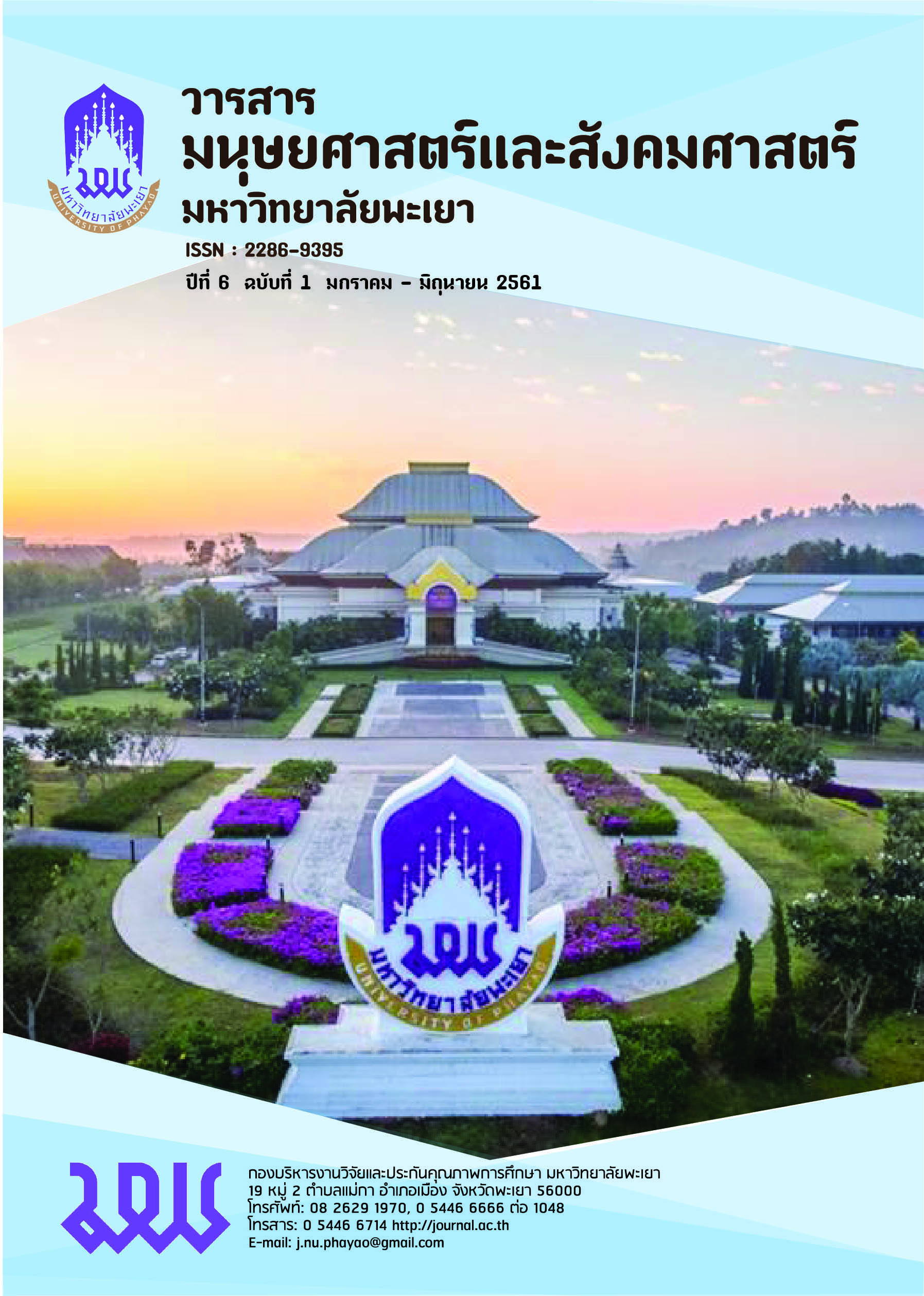การศึกษาคุณลักษณะของสื่อประเพณีจองพารา และการนำไปใช้ในการท่องเที่ยวเชิงวัฒนธรรมของจังหวัดแม่ฮ่องสอน
คำสำคัญ:
ประเพณีจองพารา, การใช้สื่อเพื่อการพัฒนา, การสื่อสารแบบมีส่วมร่วมบทคัดย่อ
คุณลักษณะของประเพณีจองพาราจากอดีตจนถึงปัจจุบันนั้น มีความแตกต่างกันอยู่ในส่วนรูปแบบโดยในอดีตจะเป็นการทำเองของแต่ละบ้าน แต่ในปัจจุบันนั้นมีการจัดทำเป็น “โครงการอบรมและร่วมอนุรักษ์สืบสานวัฒนธรรมประเพณีจองพารา” และมีการเดินขบวนแห่จองพาราเพิ่มขึ้นมา ในด้านเนื้อหา คือในอดีตประเพณีจองพาราเป็นประเพณีที่แสดงออกถึงความศรัทธาโดยมีวัตถุประสงค์เพื่อสร้างความสุขให้ครอบครัวและตนเอง แต่ในปัจจุบันเป็นประเพณีที่มีวัตถุประสงค์ไว้เพื่อสืบสานวัฒนธรรมและใช้ในการส่งเสริมการท่องเที่ยว ซึ่งในส่วนของการนำไปใช้ในการท่องเที่ยวนั้น ประเพณีจองพารามีหน้าที่เป็น สื่อ และ สาร โดยที่มีการปรับตัวใน ด้านรูปแบบและเนื้อหา แต่ยังคงคุณค่าและความหมาย ซึ่งเป็นรากที่สำคัญของประเพณีไว้อยู่โดยเจ้าของวัฒนธรรมคือคนในชุมชนบ้านเมืองปอนเองโดยมีการยินยอมและเห็นด้วยในการนำไปประเพณีจองพาราไปเป็นสื่อในการส่งเสริมการท่องเที่ยว แต่ถึงแม้กระนั้นก็ยังคงความหวงแหนในวัฒนธรรมของตนและคอยเฝ้าระวังอยู่เสมอ และจากการนำเอาสื่อประเพณีไปใช้ในการท่องเที่ยวครั้งนี้นั้น ก็ได้สร้างการมีส่วนร่วมของชุมชนบ้านเมืองปอนทั้งภาครัฐและภาคประชาชน ได้มีการให้ความร่วมมือกันเป็นอย่างดี ข้อเสนอแนะในงานวิจัย คือ การที่นักท่องเที่ยวซึ่งเป็นอีกหนึ่งกลุ่มเป้าหมายนั้นยังไม่มีการตอบรับกลับ หรือ สนใจอยากมาเยี่ยมชมงานประเพณีจองพาราแบบเจาะจงลงไปนั้น ส่วนหนึ่งผู้วิจัยคาดว่ามาจากการขาดใช้สื่ออื่น ๆ ในการโปรโมทงานประเพณีจองพารา โดยในงานวิจัยชิ้นนี้ยังคงไม่มีผลออกมาให้เห็นในเรื่องของการใช้สื่ออื่น
เอกสารอ้างอิง
นุชจรินทร์ ทับทิม. (2553). การสื่อสารอัตลักษณ์ของชุมชนบ้านวัวลาย จังหวัดเชียงใหม่ ผ่านกิจกรรมถนนคนเดิน (วิทยานิพนธ์ปริญญามหาบัณฑิต ไม่ตีพิมพ์เผยแพร่). มหาวิทยาลัยเชียงใหม่, เชียงใหม่.
ปาริชาติ สถาปิตานนท์ และคณะ. (2549). การสื่อสารแบบมีส่วนร่วมและการพัฒนาชุมชน: จากแนวคิดสู่ปฏิบัติการวิจัยในสังคมไทย. กรุงเทพฯ: สำนักงานกองทุนสนับสนุนการวิจัย.
มงคล จันทรบำรุง และสารภี ศิลา. (2545). ความคิดเห็นของชุมชนและบัณฑิตอาสาต่อโครงการจ้างบัณฑิตอาสา และผู้มีประสบการณ์ด้านการเงินเพื่อเสริมสร้างความเข็มแข็งศูนย์สงเคราะห์ราษฎรประจำหมู่บ้าน. กรุงเทพฯ: สำนักงานคณะกรรมการวิจัยแห่งชาติ.
วารินทร์ จิตคำภู. (2541). การอนุรักษ์วัฒนธรรมพื้นบ้าน (ไทยใหญ่) ในทัศนะของกรรมการบริหารสภาวัฒนธรรมอำเภอ จังหวัดแม่ฮ่องสอน (รายงานผลการวิจัย). กรุงเทพฯ: สำนักงานคณะกรรมการวัฒนธรรมแห่งชาติ กระทรวงศึกษาธิการ.
วาลิกา แสนคำ. (2545). การพัฒนาการท่องเที่ยวทางวัฒนธรรมบ้านเปียงหลวง อำเภอเวียงแหง จังหวัดเชียงใหม่ (วิทยานิพนธ์ปริญญามหาบัณฑิต ไม่ตีพิมพ์เผยแพร่). มหาวิทยาลัยเชียงใหม่, เชียงใหม่.
วิไล บุญบรรจง. (2543). การมีส่วนร่วมของประชาชนในการพัฒนาแหล่งท่องเที่ยวบริเวณชายฝั่งทะเลเมืองระยอง อำเภอเมือง จังหวัดระยอง (วิทยานิพนธ์ปริญญามหาบัณฑิต ไม่ตีพิมพ์เผยแพร่). มหาวิทยาลัยเชียงใหม่, เชียงใหม่.
วันทนา เตชะสุวรรณา. (2548). บทบาทของสื่อบุคคลและสื่อประเพณีในการถ่ายทอดวัฒนธรรมประเพณีของชาวบางกอกน้อย: ศึกษาเฉพาะกรณี ชุมชนบ้านบุ (วิทยานิพนธ์ปริญญามหาบัณฑิต) มหาวิทยาลัยธรรมศาสตร์. กรุงเทพฯ.
สมควร กวียะ. (2555). ความรู้ทั่วไปเกี่ยวกับสื่อเพื่อการประชาสัมพันธ์ สำนักงานจังหวัดแม่ฮ่องสอน. รายได้การท่องเที่ยว. สืบค้นจาก http://123.242.182.10/kpi2013/index.php/growth-kpi-6 P.2
สุรีย์ บุญญานุพงศ์ และสุรศักดิ์ ป้อมทองคา. (2539). ประเพณีเพื่อการท่องเที่ยว : จุดเปลี่ยนของระบบความสัมพันธ์ทางสังคม. เชียงใหม่: สถาบันวิจัยสังคม มหาวิทยาลัยเชียงใหม่.
Cohen, John M. and Uphoff, Norman T. (1980). Participation’s place in rural develop: Seeking clarity through specificity. New York: World Development.
ดาวน์โหลด
เผยแพร่แล้ว
รูปแบบการอ้างอิง
ฉบับ
ประเภทบทความ
สัญญาอนุญาต
ผู้นิพนธ์ต้องรับผิดชอบข้อความในบทนิพนธ์ของตน มหาวิทยาลัยพะเยาไม่จำเป็นต้องเห็นด้วยกับบทความที่ตีพิมพ์เสมอไป ผู้สนใจสามารถคัดลอก และนำไปใช้ได้ แต่จะต้องขออนุมัติเจ้าของ และได้รับการอนุมัติเป็นลายลักษณ์อักษรก่อน พร้อมกับมีการอ้างอิงและกล่าวคำขอบคุณให้ถูกต้องด้วย
The authors are themselves responsible for their contents. Signed articles may not always reflect the opinion of University of Phayao. The articles can be reproduced and reprinted, provided that permission is given by the authors and acknowledgement must be given.








